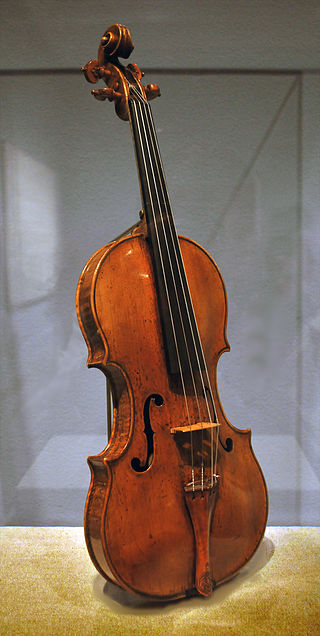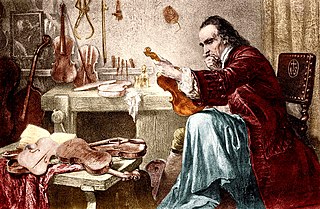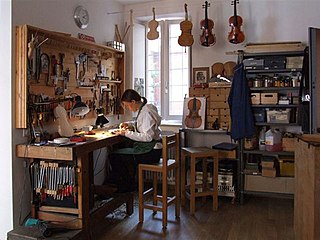
Amati is the last name of a family of Italian violin makers who lived at Cremona from about 1538 to 1740. Their importance is considered equal to those of the Bergonzi, Guarneri, and Stradivari families. Today, violins created by Nicolò Amati are valued at around $600,000. Because of their age and rarity, Amati instruments are mostly kept in museum or private collections and are seldom played in public.

Antonio Stradivari was an Italian luthier and a craftsman of string instruments such as violins, cellos, guitars, violas and harps. The Latinized form of his surname, Stradivarius, as well as the colloquial Strad are terms often used to refer to his instruments. It is estimated that Stradivari produced 1,116 instruments, of which 960 were violins. Around 650 instruments survive, including 450 to 512 violins. His instruments are considered some of the finest ever made, and are extremely valuable collector's items.

A Stradivarius is one of the violins, violas, cellos and other string instruments built by members of the Italian family Stradivari, particularly Antonio Stradivari, during the 17th and 18th centuries. They are considered some of the finest instruments ever made, and are extremely valuable collector's items.

A luthier is a craftsperson who builds or repairs string instruments.

Jean-Baptiste Vuillaume was a French luthier, businessman, inventor and winner of many awards. His workshop made over 3,000 instruments.

A tailpiece is a component on many stringed musical instruments that anchors one end of the strings, usually opposite the end with the tuning mechanism.
Francesco Rugeri, also known as Ruger, Rugier, Rugeri, Ruggeri, Ruggieri, Ruggerius, was the first of an important family of luthiers, the Casa Rugeri in Cremona, Italy. His instruments are masterfully constructed. His violins are inspired by Nicolò Amati's "Grand Amati" pattern. Francesco was the first to develop a smaller cello design, which has become the standard for modern cello dimensions. Today, Rugeri's instruments are nearly as renowned as Nicolò Amati's instruments.
Sanctus Seraphin, also known as Santo Serafin, was a successful luthier, working in Venice. He closed his bottega (workshop) in 1741 but he continued to work in the bottega of Giorgio Serafin, his nephew, till his death in 1776. It is still unknown where he learned the art of violin making. His models were inspired to the Cremonese luthier Nicolò Amati.
Joseph Curtin is an American contemporary violinmaker who lives in Ann Arbor, Michigan. He is recognised as one of the world's greatest violinmakers.
Samuel Zygmuntowicz is a contemporary luthier and is widely regarded as one of the finest violin makers of his generation. He began his instrument making training at age 13, and studied making and restoration under Peter Prier, Carl Becker and René Morel. Since 1985 he has been based in Brooklyn, New York. His early work demonstrates expert skill as a copyist of classic instruments. Later work includes personal models informed by intensive advanced research. Findings from this research have been published in numerous print and digital media. Zygmuntowicz is an active fiddler, playing with several folk music groups. His playing can be heard on the recordings Grand Picnic, and Jump When the Trumpets Blow.

Carlo Bisiach (1892–1968) was a violin maker born in Milan, Italy. Bisiach's work contributed to the rebirth of violin making in the region after the difficult times of World War I and World War II. After working with his father Leandro in Milan and then Siena, Carlo established himself at Florence in 1922. The most talented of Leandro's sons, Carlo went on to develop his own style quite separate from the Antoniazzi-derived work of his father and brothers.

Leandro Bisiach was an Italian violin maker, who was born in Casale Monferrato and died in 1945 in Venegono Superiore near Varese.
Andrea Guarneri was an Italian luthier, musician and founder of the Casa Guarneri. He is the most important student of Nicola Amati and grandfather of one of the best luthiers, Bartolomeo Giuseppe Guarneri, del Gesù.
Gregg T. Alf is a prominent contemporary American violin maker based in Ann Arbor, Michigan.
Stewart Pollens is an expert on historical musical instruments. His work includes restoration, analysis, and scholarly publication; and it embraces keyboard instruments as well as historical stringed instruments such as the violin and cello. Andrew Manze has called him "one of the world’s foremost authorities on musical instruments."

Nicola Amati, Nicolò Amati or Nicolao Amati was an Italian master luthier from Cremona, Italy. Amati is one of the most well-known luthiers from the Casa Amati. He was the teacher of illustrious Cremonese School luthiers such as Andrea Guarneri and Giovanni Battista Rogeri. While no clear documentation exists for their being apprentices in his shop, Amati may also have apprenticed Antonio Stradivari, Francesco Rugeri, and Jacob Stainer, as their work is heavily influenced by Amati.
Keith Richard Hill is a prize winning American maker of musical instruments He has conducted research into the acoustical technology employed by musical instrument makers from 1550–1850, and used this knowledge to create hundreds of harpsichords, clavichords and other instruments.
The Langonet Dynasty were a family of violin makers originating in Mirecourt, France, from around 1737 until the late 1900s.
Vincenzo Rugeri, was an Italian luthier of string instruments such as violins, cellos, and, violas in Cremona, Italy. His instruments are noted for their craftsmanship and tone quality. Vincenzo came from a distinguished family of luthiers, the first of whom was his father, Francesco Rugeri. Despite the local tradition of artisan families laboring together through generations, Vincenzo left the family shop and set up a successful shop of his own in the center of Cremona. Vincenzo was the third son of luthier Francesco Rugeri. Vincenzo's work, like Francesco's, is influenced by Nicolò Amati's Grand Pattern model, however Vincenzo's work was distinguished from his father's by utilizing a lower arch inspired by Antonio Stradivari. An analysis of the body of his work reveals that the quality of Vincenzo's instruments is remarkable, perhaps even more so than his father's. Vincenzo's instruments, though less numerous, are valued at least equal to those of his father. A violin by Vincenzo Rugeri realized $502,320 on October 3, 2011 at Brompton's Auctions in London. Carlo Bergonzi was a distinguished apprentice of Vincenzo Rugeri.

Giacomo Bisiach was an Italian luthier.










